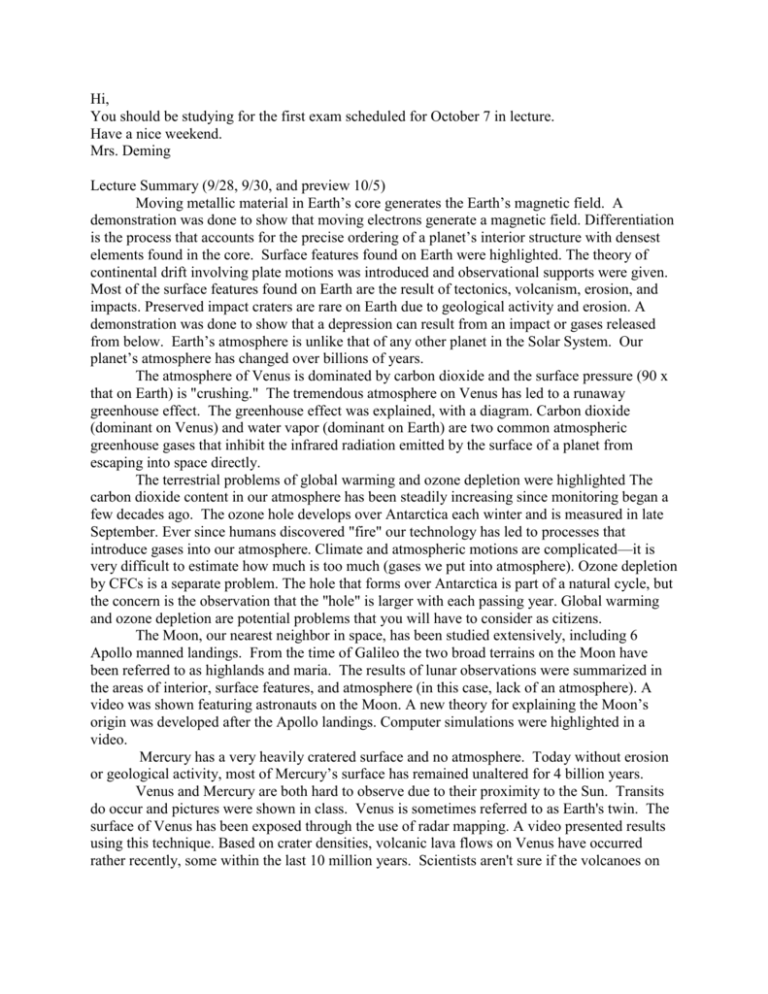Our own Earth's interior structure, and surface features will be
advertisement

Hi, You should be studying for the first exam scheduled for October 7 in lecture. Have a nice weekend. Mrs. Deming Lecture Summary (9/28, 9/30, and preview 10/5) Moving metallic material in Earth’s core generates the Earth’s magnetic field. A demonstration was done to show that moving electrons generate a magnetic field. Differentiation is the process that accounts for the precise ordering of a planet’s interior structure with densest elements found in the core. Surface features found on Earth were highlighted. The theory of continental drift involving plate motions was introduced and observational supports were given. Most of the surface features found on Earth are the result of tectonics, volcanism, erosion, and impacts. Preserved impact craters are rare on Earth due to geological activity and erosion. A demonstration was done to show that a depression can result from an impact or gases released from below. Earth’s atmosphere is unlike that of any other planet in the Solar System. Our planet’s atmosphere has changed over billions of years. The atmosphere of Venus is dominated by carbon dioxide and the surface pressure (90 x that on Earth) is "crushing." The tremendous atmosphere on Venus has led to a runaway greenhouse effect. The greenhouse effect was explained, with a diagram. Carbon dioxide (dominant on Venus) and water vapor (dominant on Earth) are two common atmospheric greenhouse gases that inhibit the infrared radiation emitted by the surface of a planet from escaping into space directly. The terrestrial problems of global warming and ozone depletion were highlighted The carbon dioxide content in our atmosphere has been steadily increasing since monitoring began a few decades ago. The ozone hole develops over Antarctica each winter and is measured in late September. Ever since humans discovered "fire" our technology has led to processes that introduce gases into our atmosphere. Climate and atmospheric motions are complicated—it is very difficult to estimate how much is too much (gases we put into atmosphere). Ozone depletion by CFCs is a separate problem. The hole that forms over Antarctica is part of a natural cycle, but the concern is the observation that the "hole" is larger with each passing year. Global warming and ozone depletion are potential problems that you will have to consider as citizens. The Moon, our nearest neighbor in space, has been studied extensively, including 6 Apollo manned landings. From the time of Galileo the two broad terrains on the Moon have been referred to as highlands and maria. The results of lunar observations were summarized in the areas of interior, surface features, and atmosphere (in this case, lack of an atmosphere). A video was shown featuring astronauts on the Moon. A new theory for explaining the Moon’s origin was developed after the Apollo landings. Computer simulations were highlighted in a video. Mercury has a very heavily cratered surface and no atmosphere. Today without erosion or geological activity, most of Mercury’s surface has remained unaltered for 4 billion years. Venus and Mercury are both hard to observe due to their proximity to the Sun. Transits do occur and pictures were shown in class. Venus is sometimes referred to as Earth's twin. The surface of Venus has been exposed through the use of radar mapping. A video presented results using this technique. Based on crater densities, volcanic lava flows on Venus have occurred rather recently, some within the last 10 million years. Scientists aren't sure if the volcanoes on Venus are still active. Without seismic data, scientists do not yet have a good model for the interior of Venus. Mars has long been recognized as the planet most like Earth, holding hopes of Martian life. Surface conditions on Mars today are very inhospitable to life. A demonstration was done to show that on the Martian surface with very low pressure, water would boil. Spacecraft observations have revealed the largest volcanoes and fault features in the Solar System on Mars. There is also evidence that water once flowed across the Martian surface indicating a wetter, warmer Mars with greater atmospheric pressure in the past. Currently Mars is locked in an extended ice age. TERMS: tectonics, continental drift, paleomagnetism, plate tectonics, mid-Atlantic ridge impact craters, maria, highlands, transit, radar mapping, shield volcanoes, greenhouse effect, greenhouse gases, visible light, infrared radiation, global warming, ozone, polar caps, rift valley, Valles Marineras, runoff channels, Viking mission, Spirit and Opportunity landers/rovers QUESTIONS: 1. What observations support the theory of continental drift? 2. Give examples of how plate tectonics creates surface features on Earth. 3. What processes change Earth’s surface over time? 4. How has Earth’s atmosphere changed over time? What supports this theory? 5. Describe how a planet's surface temperature can be elevated by the greenhouse effect. 6. Compare the problems of global warming and ozone depletion. . 7. Describe the major surface features on the Moon. 8. Explain why the surface of the Moon looks so different compared to the surface of the Earth. 9. Mercury looks more like the Moon than the Earth. Explain why. 10. How has the surface of Venus been mapped? What discoveries were made? 11. Why are the volcanoes on Mars so much larger than those on Earth? 12. What evidence exists to support the hypothesis that water once flowed over Mars?











